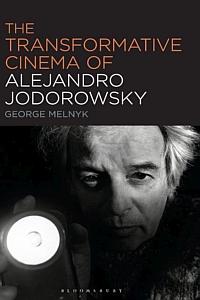Few other artists connected with auteur cinema have left such a record of often disturbing, mythical, surreal, and sometimes more or less incomprehensible movies as Alejandro Jodorowsky, Chilean director extraordinaire, born in 1929. If the label “cult director” can be applied to just a few artists, he definitely is in that league.
 “Jodorowsky has invested himself at the deepest personal level in his cinema because he sees it as transformative and life-changing for those involved in its making as well as those who view it. The demand that his cinema be transformative turns him into a self-styled therapist, a healer of the psyche, and a transformer of personal identity.”
“Jodorowsky has invested himself at the deepest personal level in his cinema because he sees it as transformative and life-changing for those involved in its making as well as those who view it. The demand that his cinema be transformative turns him into a self-styled therapist, a healer of the psyche, and a transformer of personal identity.”
Even if his name may sound unfamiliar at first, film fans will – probably – recall his most celebrated movies: El Topo (1970), The Holy Mountain (1973) and Psychomagic, A Healing Art (2019). Apart from those works, he also directed the movies La Cravate (1957), Fando y Liz (1968), Dune (it unfortunately did not make it past the planning stage (1974-1976)), Tusk (1980), Santa Sangree (1989), The Rainbow Thief (1990), The Dance of Reality (2013), and Endless Poetry (2016).
El Topo, for example, was quickly identified by audiences as the perfect situation to experience mind-expanding drugs and, for some time, shift into the surreal, subconscious, mystic, disturbing, and psychedelic environments and sounds the film offered. Intellectuals, hippies, and counter-culture celebrities soon idolized Jodorowsky.
Unlike most other directors, regardless of their creative periods and commercial success, Jodorowsky became a master of many other arts in just one lifetime. He is also a “… novelist, cartoonist, poet, playwright, graphic novelist, psychotherapist, shamanistic healer, actor, mime artist, Tarot master, and theater director.”
For the most part, his films were financial disasters for his producers, and some of his early pictures were unavailable in the US for decades. For several reasons, such as his other callings as a New Age philosopher or graphic artist, he decided to take a break from his career as a director for almost thirty years.
The Transformative Cinema of Alejandro Jodorowsky is only the second English language book-length study of the man and his work. In this case, this definition is crucial. Jodorowsky usually added autobiographical anecdotes, personal experiences (mostly spiritual and mystical ones), parts of his family’s record, and bits and pieces from his other artistic fields of production to many of his movies. Those links, anecdotes, and allusions often reappear after several years in his later movies since, after all, his creative years cover six decades. Which means that one topic, a particular experience of one of his 1960s’ movies, may easily resurface in another of his films from the 1980s.
Melnyk basically argues that Jodorowsky’s works are unique and use more than surreal moments of confusion or sensationalism; instead, they should be recognized as “major works of art with a thematic and visual unity, as well as providing a profound sense of the absurdity, hypocrisy, and ambiguity of the human condition.”
The book is quite a find, as Jodorowsky’s output is extremely hard to define; the mass of essays, interviews, and recollections from French, Spanish, and English sources used here tell of the infinite efforts to classify him. Even academic writing more often than not tried to label him but encountered many difficulties, as he was not “just” the man who incorporated autobiographical elements in his movies, was simply “phantasmagorical,” or tried to mold several art forms and styles into something yet unnamed.
Furthermore, Melnyk, Professor Emeritus of Communication, Media, and Film at the University of Calgary, Canada, stays true to a basically non-academic and highly informative style. It was this style and “academic attitude” that, in his eyes, caused part of the many misinterpretations concerning the director. Simply because many academics and journalists (and even film critics) were desperately looking for tags and usable theories to classify the director, only to realize he was somehow “too large” to fit such categories. Melnyk understands Jodorowsky ’s films as a fusion of mindsets and spiritual exercise: “… the ways he integrates theatrical practices and ideas, transformative psycho-healing therapies, and his work in comics into his cinema. … When a filmmaker insists that his films become psychologically transformative happenings, then scholars become nervous.”
The book opens with two introductions or brief autobiographical sketches, as so much needs to be said first about the filmmaker and man with a very special CV. The following eight chapters deal with the individual movies and the many stories behind the filming, the respective scripts, location searches, and production histories. With very interesting details that reveal the “wholeness” Jodorowsky wanted to archive with each picture, starting with production. Chapter five, “The Ascent of and the Decent from The Holy Mountain,” is apparently the most intriguing text that centers on his style of filming and directing. The final section, however, “Jodorowsky Redux: Evaluating the Art of a Fabulist” is an eye-opener and a much appreciated and clear conclusion, appreciated by probably many film enthusiasts.
Review by Dr. A. Ebert © 2023
George Melnyk. The Transformative Cinema of Alejandro Jodorowsky. Bloomsbury Academic, 2023, 208 p.
